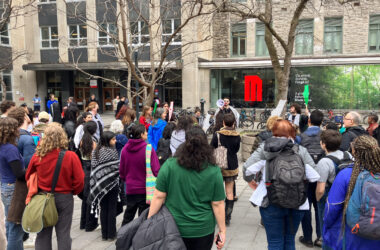In the last couple of years, overcrowding has become a major problem in Montreal CEGEPs. Simply put, there are more students who have the proper academic credentials than there are spots available.
On January 20, the Gazette reported that the Quebec government is going to wait until after the March 1 deadline to decide how much to commit to Montreal’s overcrowded CEGEPS. The Montreal CEGEPs, however, are already dealing with the effects of being told to take additional students.
Vanier College, for instance, had to turn away a number of top-quality students due to space restrictions in 2010. Good students were told they would have to take night classes instead of studying full-time. Vanier was eventually allowed to accept the students it initially designed, but not without a strain.
“[Between 2005 and 2010], we have grown 14.5 per cent in the number of students in the school, [which] has brought us to 900 over our normal limit,” said Gilbert Heroux, Vanier’s director general.
CEGEPs all across Montreal have had to take more students to accommodate the growing amount of high school graduates.
“[The government] told us we had to take an extra 300 students last year and now they’re telling us to take another 300, so we’re 600 over our normal limits” said Paul Rastelli, coordinator of student services at Dawson College for the last 10 years.
At Dawson, Rastelli said that they had acquired seven new classrooms and two new computer labs from the Pepsi Forum across the street to accommodate new students. But other CEGEPs haven’t been so lucky.
John Abbott College, located in the West Island near the Macdonald campus of McGill, started construction on a new building in August 2010.
“But that won’t be finished until 2014, so it’s still very crowded especially in places where people gather,” said Andrew Shulman, a student at John Abbott in his eighth semester, currently in the creative art, languages, and literature program.
“It’s because more kids are graduating high school and seeing the benefits of going to CEGEP,” he said, “and also older people are coming back in order to either go into professional programs to change careers, or just looking to get an extra degree to be more competitive on the job market.”
Heroux, however, differed on why he thought there were more students.
“It’s just because of a demographic boom we had which is showing now in more high school graduates,” he said. “This is a problem which is going to solve itself in two to four years. We need a strong government initiative temporarily because it is a problem which will solve itself”
Of course, there are some benefits to having a larger student body. Jesse Binstock, recreation technician in charge of campus recreation and league sports at Dawson College said that campus sports participation this year has not been higher since 2001.
“From an athletics standpoint we’ve had the best year ever,” he said. “Every team had to make cuts [after tryouts]. Teams are the best they’ve ever been. We had 150 people try out for two spots on the AAA basketball team this year.”
Although it has been a great year for athletic achievement, Binstock said that an insufficient number of support staff has made running his office difficult. The approval of Bill 100 last summer, designed to reduce debt and return a balanced budget, has made the overcrowding even more logistically challenged.
The bill affects not only CEGEPs but universities such as McGill as well, in stipulating that for every two support staff, there can only be one replacement. As the staff ranks thin, student populations are exploding.








